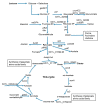Transcriptomic Analysis of Staphylococcus xylosus in Solid Dairy Matrix Reveals an Aerobic Lifestyle Adapted to Rind
- PMID: 33212972
- PMCID: PMC7698506
- DOI: 10.3390/microorganisms8111807
Transcriptomic Analysis of Staphylococcus xylosus in Solid Dairy Matrix Reveals an Aerobic Lifestyle Adapted to Rind
Abstract
Staphylococcus xylosus is found in the microbiota of traditional cheeses, particularly in the rind of soft smeared cheeses. Despite its frequency, the molecular mechanisms allowing the growth and adaptation of S. xylosus in dairy products are still poorly understood. A transcriptomic approach was used to determine how the gene expression profile is modified during the fermentation step in a solid dairy matrix. S. xylosus developed an aerobic metabolism perfectly suited to the cheese rind. It overexpressed genes involved in the aerobic catabolism of two carbon sources in the dairy matrix, lactose and citrate. Interestingly, S. xylosus must cope with nutritional shortage such as amino acids, peptides, and nucleotides, consequently, an extensive up-regulation of genes involved in their biosynthesis was observed. As expected, the gene sigB was overexpressed in relation with general stress and entry into the stationary phase and several genes under its regulation, such as those involved in transport of anions, cations and in pigmentation were up-regulated. Up-regulation of genes encoding antioxidant enzymes and glycine betaine transport and synthesis systems showed that S. xylosus has to cope with oxidative and osmotic stresses. S. xylosus expressed an original system potentially involved in iron acquisition from lactoferrin.
Keywords: Staphylococcus; cheese model; nutrient shortage; osmotic stress; oxidative stress; physiology.
Conflict of interest statement
The authors declare that the research was conducted in the absence of any commercial or financial relationships that could be construed as a potential conflict of interest.
Figures



Similar articles
-
Adaptation of Staphylococcus xylosus to Nutrients and Osmotic Stress in a Salted Meat Model.Front Microbiol. 2016 Feb 5;7:87. doi: 10.3389/fmicb.2016.00087. eCollection 2016. Front Microbiol. 2016. PMID: 26903967 Free PMC article.
-
Transcriptomic analysis of Staphylococcus xylosus in the presence of nitrate and nitrite in meat reveals its response to nitrosative stress.Front Microbiol. 2014 Dec 15;5:691. doi: 10.3389/fmicb.2014.00691. eCollection 2014. Front Microbiol. 2014. PMID: 25566208 Free PMC article.
-
Investigating Extracellular DNA Release in Staphylococcus xylosus Biofilm In Vitro.Microorganisms. 2021 Oct 21;9(11):2192. doi: 10.3390/microorganisms9112192. Microorganisms. 2021. PMID: 34835318 Free PMC article.
-
Insight into the Genome of Staphylococcus xylosus, a Ubiquitous Species Well Adapted to Meat Products.Microorganisms. 2017 Aug 29;5(3):52. doi: 10.3390/microorganisms5030052. Microorganisms. 2017. PMID: 28850086 Free PMC article. Review.
-
Carbon catabolite repression by the catabolite control protein CcpA in Staphylococcus xylosus.J Mol Microbiol Biotechnol. 2002 May;4(3):309-14. J Mol Microbiol Biotechnol. 2002. PMID: 11931563 Review.
Cited by
-
Beyond the Wild MRSA: Genetic Features and Phylogenomic Review of mecC-Mediated Methicillin Resistance in Non-aureus Staphylococci and Mammaliicocci.Microorganisms. 2023 Dec 29;12(1):66. doi: 10.3390/microorganisms12010066. Microorganisms. 2023. PMID: 38257893 Free PMC article. Review.
-
Bacterial-fungal interactions promote parallel evolution of global transcriptional regulators in a widespread Staphylococcus species.ISME J. 2023 Sep;17(9):1504-1516. doi: 10.1038/s41396-023-01462-5. Epub 2023 Jul 31. ISME J. 2023. PMID: 37524910 Free PMC article.
References
LinkOut - more resources
Full Text Sources
Research Materials

